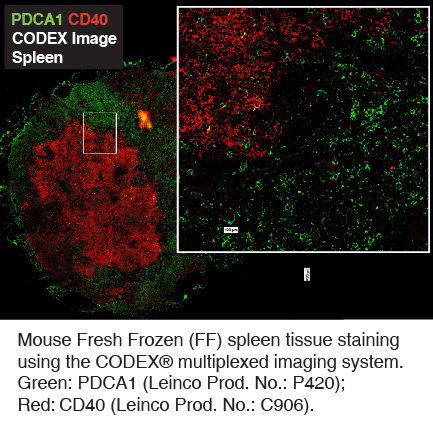Anti-Mouse CD40-BX045 (3/23); Alexa Fluor™ 647-RX045
Anti-Mouse CD40-BX045 (3/23); Alexa Fluor™ 647-RX045
Product No.: C906
- -
- -
Clone 3/23 Target CD40 Formats AvailableView All Product Type Monoclonal Antibody Isotype Rat IgG1 κ Applications IHC FF , PhenoCycler® |
- -
- -
Select Product Size | Qty Max: Min: 1 Step: 1 $675.00 |
Data
- -
- -
CODEX® DetailsBarcode BX045 Reporter Alexa Fluor™ 647-RX045 Tissue Screened Spleen Tissue Preparation FF (Fresh Frozen) Antibody and Reporter DetailsReactivity Species Mouse Host Species Rat Immunogen Recombinant mouse CD40 protein Formulation This PhenoCycler-Fusion (CODEX)® barcoded antibody is formulated in phosphate buffered saline (150 mM NaCl) PBS, EDTA pH 7.2 containing 0.09% sodium azide as a preservative. The CODEX® reporter is formulated in 1X Tris-EDTA (TE) pH 8.0 (10 mM Tris-HCl, 1 mM disodium EDTA, pH 8.0) Product Preparation Manufactured in an animal-free facility using only in vitro cell culture techniques, purified by affinity chromatography, and conjugated to a specific barcode under optimal conditions. State of Matter CODEX® barcoded antibody - Liquid; CODEX® reporter - Liquid Storage and Handling This PhenoCycler-Fusion (CODEX)® barcoded antibody is stable when stored at 2-8°C for up to 1 year (do not freeze). The CODEX® reporter is stable when frozen at -20°C for up to 1 year. Applications and Recommended Usage? Quality Tested by Leinco CODEX®; IHC FF - The suggested dilution for staining tissue in immunohistochemistry - Fresh Frozen (FF) is 1-2 μl of Anti-Mouse CD40 (BX045) in a final volume of 200 μl of CODEX® staining buffer. Country of Origin USA Each investigator should determine their own optimal working dilution for specific applications. See directions on lot specific datasheets, as information may periodically change. DescriptionSpecificity Clone 3/23 recognizes an epitope on mouse CD40. Antigen Distribution CD154 is expressed on activated CD4+ T cells. Background CD40, also known as TNFSF5, is a type I transmembrane protein and member of the TNF receptor family. The binding of CD40L (CD154) on TH cells to CD40 activates antigen presenting cells and induces a variety of downstream effects1. CD40 is expressed on B cells, dendritic cells, monocytes, thymic epithelial cells and, at low levels, on T cells 2. Signaling though CD40 plays an important role in the proliferation and differentiation of B cells and is critical for immunoglobulin (Ig) class switching3. The membrane-anchored CD40L is expressed almost exclusively on activated CD4+ T lymphocytes. Failure to express CD40L leads to "immunodeficiency with hyper-IgM", a disease characterized by failure to produce IgG, IgA and IgE. Some of the early intracellular signaling by the CD4-CD40L system includes the association of the CD40 with TRAFs and the activation of various kinases 4. Adaptor protein TNFR2 interacts with this receptor and serves as a mediator of the signal transduction. The interaction of CD4-CD40L is found to be necessary for amyloid-beta-induced microglial activation, and thus is thought to be an early event in Alzheimer disease pathogenesis.
PhenoCycler-Fusion (CODEX)® reporters are made up of a fluorescent dye and a short oligonucleotide DNA barcode called a PhenoCycler-Fusion (CODEX)® Tag. Fluorescent reporters enable highly specific detection of corresponding barcodes, and the use of spectrally separated dyes allow for precise signal detection in up to three distinct fluorescence channels at one time. Antigen DetailsProtein PubMed NCBI Gene Bank ID References & Citations1. Grewall, I. S. et al. (1996) Science 73:1864 2. Schonbeck, U. et al. (1997) J. Biol. Chem. 272:19569 3. Armitage, R. J. et al. (1993) J. Immunol. 150:3671 4. Pullen, S. S. et al. (1999) Biochemistry 38:10168 Technical Protocols |
Formats Available
- -
- -



